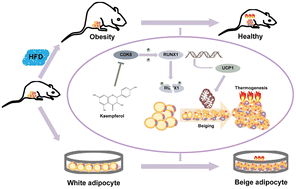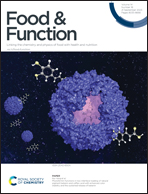Kaempferol regulates the thermogenic function of adipocytes in high-fat-diet-induced obesity via the CDK6/RUNX1/UCP1 signaling pathway†
Abstract
Activation of adipose tissue thermogenesis is a promising strategy in the treatment of obesity and obesity-related metabolic disorders. Kaempferol (KPF) is a predominant dietary flavonoid with multiple pharmacological properties, such as anti-inflammatory and antioxidant activities. In this study, we sought to characterize the role of KPF in adipocyte thermogenesis. We demonstrated that KPF-treated mice were protected from diet-induced obesity, glucose tolerance, and insulin resistance, accompanied by markedly increased energy expenditure, ex vivo oxygen consumption of white fat, and increased expression of proteins related to adaptive thermogenesis. KPF-promoted beige cell formation is a cell-autonomous effect, since the overexpression of cyclin-dependent kinase 6 (CDK6) in preadipocytes partially reversed browning phenotypes observed in KPF-treated cells. Overall, these data implicate that KPF is involved in promoting beige cell formation by suppressing CDK6 protein expression. This study provides evidence that KPF is a promising natural product for obesity treatment by boosting energy expenditure.



 Please wait while we load your content...
Please wait while we load your content...